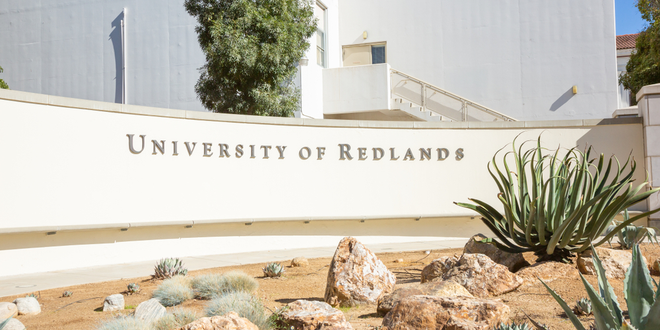Proposed by the University of Redlands, the mixed-use project would serve as a gathering place for the city and the university, in addition to providing more residential and retail. development. One Redlands official says he’s anxious to see the proposal, which yet to be presented to the city.
If the University of Redlands has its way, the campus train station scheduled to begin operating this year will be the unofficial first phase of a proposed mixed-use development that will cover 30 acres.
University Village will be developed around University Station, which is being built near Park Avenue and University Street near the campus. Both the development and the station will be bordered by Zanja Creek.
University Station will serve the Arrow Line, a nine-mile rail line that will connect San Bernardino with Redlands. That project, which is being developed by the San Bernardino County Transportation Authority, will cost nearly $400 million and is expected to begin operating this year, according to the authority’s website.
University Village, which is still being planned and has yet to be submitted to the city, would have approximately one million square feet of developed space when it’s completed, according to www.redlands.edu/universityvillage.
University Village could transform not only the university but all of Redlands, said Krista Newkirk, university president.
A similar project developed at the University of North Carolina-Charlotte helped that school double its enrollment during an 18-year period, Newkirk said.
“University Village is potentially a huge benefit for the university and for the city,” said Newkirk, who has thrown her full support behind the project since taking office in July.
“It will reduce traffic and parking and save the city money in the long run. It will also make it easier for people to get on and off campus.”
University Village would include a mix of two, three and four-story buildings, with much of the development to take place away from the residential neighborhoods adjacent to the 115-year-school. One building would be a 70-room hotel with rooftop dining, and the project would include a large green space that could be used for concerts, farmer’s markets and other public gatherings.
As proposed, about 35 percent of University Village will be open space landscaping and setback areas. Most projects as large as University Village don’t include that much open space, according to the website.
University Village will also have housing of different sizes, and retail. The retail component will likely include restaurants, offices, and live-work spaces. About $80 million in infrastructure improvements will have to be completed before construction can begin, according to the website.
Last August, university officials went before the city council and discussed the first details regarding the project. Three months later they announced they had found a developer: REACH Redlands LLC, a joint venture of Pomona-based Arteco Partners, Creative Housing Associates in Los Angeles and Republic Metropolitan in San Francisco.
Arteco Partners specializes in reviving downtowns. It’s been the driving force in bringing back downtown Pomona, starting with the restoration of the Fox Theater and the Mayfair Hotel, both city landmarks with long histories.
Creative Housing Associates prepared the first report for University Village. Republic Metropolitan is a real estate development company that works with transit-oriented projects.
If approved, the project will create jobs and generate tax revenue for the city, according to the website, which offers no numbers to support those claims.
It would also reduce air pollution, eliminate urban sprawl and create a public gathering place for the city as well as the university similar to a European village green.
Ultimately, University Village will serve as the gateway for people visiting the university whether they get there by automobile, bicycle, train or by foot.
“But we want this to be about more than transportation,” Newkirk said. “We want something that will be a gathering place that the entire city can use.”
University Station will be an example of transit oriented development, which creates “compact, walkable, pedestrian-oriented, mixed-use communities centered around high quality train systems,” according to the Transit Oriented Development Institute, a division of the U.S. High Speed Rail Association in Washington, D.C.
Transit oriented development emphasizes walking, making pedestrians the highest priority, and it uses a train station as the centerpiece for community interaction.
Done correctly, transit oriented development can improve a community’s quality of life by increasing transit ridership reducing traffic and creating more foot traffic for businesses. Local governments also save money because they won’t have to build as many roads or manage a sprawling population, according to the association.
In addition to University Station, Redlands will have two other stations on the Arrow Line route: the Esri station, north of Redlands Boulevard and New York Street near the Esri campus, and the Downtown Station between Eureka and Orange streets north of the historic Santa Fe Depot.
Redlands also plans to develop around those two properties, so University Village is in sync with with what the city intends to do with its new train stations.
However, it’s difficult for any Redlands official to comment on University Village until a plan is submitted, said Mayor Pro Tem Eddie Tejada.
“I want to know exactly what’s being proposed before I make any comment,” Tejada said. “The planning commission will get first look at it, and I will be interested in what they have to say. There are a lot of issues, like density and traffic, and a lot of numbers that still have to be addressed.”
 IE Business Daily Business news for the Inland Empire.
IE Business Daily Business news for the Inland Empire.


